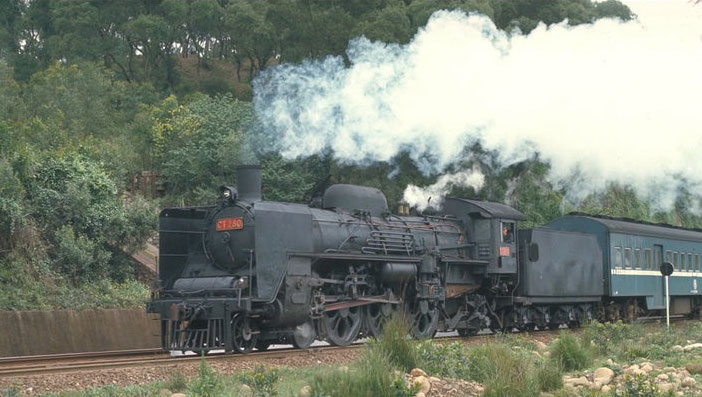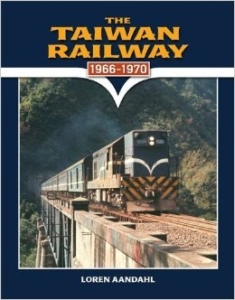Taiwan is a superb destination for rail fans: there’s the new bullet train, Taipei’s showcase MRT, the scenic East Coast railways, the busy main trunk western line, quaint branch lines, and the magnificent Alishan narrow-gauge forestry railway, which climbs a stunning two-thousand meters. Not that you’d know that from the English-language press – titles on the subject are a glaring omission from the bookshelves. Thankfully, American railway enthusiast Loren Aandahl is putting this right. In 2011 he self-published the photo book The Taiwan Railway: 1966–1970, followed a year later by The Taiwan Railway: 1971–2002. Other books are planned.
Aandahl (the surname is Norwegian) began his Taiwan adventure wearing nappies, arriving in the city of Hsinchu with his Lutheran missionary parents in 1955 at the age of eighteen months. Hsinchu would be his home for the next sixteen years. Among Loren’s earliest childhood memories are countless hours spent watching trains at a railway crossing near his home. It was a fascination that he never grew out of. When he attended boarding school at Taichung’s Morrison Academy (from 1959 to 1970) the highlight was the fortnightly train trip between school and home. During his high school years he acquired a camera and began taking pictures of the railway. The resulting pictures, along with others taken on family trips around the island, are the heart of The Taiwan Railway: 1966–1970. His photographs are a rare record of the railways during a time of strict martial law, when photography of strategic infrastructure was prohibited. Taking these pictures involved daring and guile. Although Loren could – being a foreigner – get away with more than Taiwanese citizens, he still had serious run-ins with the authorities.
In 1970 Loren moved to the United States to attend college. Working in the aviation industry in the ensuing decades meant cheap flights for frequent visits back to Taiwan, where he continued to ride the rails and document the evolution of the country’s railways. Pictures from these trips – supplemented by ones from several fellow Americans who were resident on the island in the early seventies – were compiled to produce The Taiwan Railway: 1971–2002.
I came across both of Aandahl’s books in a Taipei store last year, and bought the second one for a very reasonable NT$950 (both titles are available through Amazon for about US$45). These books will appeal to two main groups: hardcore train-spotters and then others like me, who, while not knowing their angle cocks from their hoop tablets, have some emotional attachment to Taiwan’s railways for the periods covered.
During the mid-1990s I lived in a small town in central Taiwan on the main western rail line. Trains meant much-anticipated visits to nearby cities. I have especially fond memories of lazy rides on the slow, rattling putongche trains (long since replaced by the silver commuter electric trains). The antiquated carriages had old-school windows that you could slide up for a pleasant breeze and an unobstructed view of the rice fields rolling by. Whatever the class of train, arriving at a station always had a touch of magic to it. Leaving the countryside, you’d quickly ease past rows of grimy city back walls and disembark at stations which – with their Japanese colonial-era architecture, quaint topiary, and railway staff in old-fashioned uniforms – were a taste of pre-KMT Formosa. And then, finally stepping out from the shade of the station, you were hit with all the colour and bustle of modern main-street Taiwan.
The Taiwan Railway: 1971–2002 has a very straightforward layout, chronologically following Loren Aandahl’s trips to the island. After an introduction, there are fourteen chapters – each covering a year during the 32-year period, and starting with a picture and half a page of text. After that it’s typically two images per page, with detailed captions. The photographs are good but not prize-winning; they’re descriptive rather than arty – you won’t find any silhouettes of locomotives or close-ups of abstract mechanical shapes. The majority of the pictures are colour, taken with slide film, which, now that digital is so dominant, impart a nostalgic quality that suits the subject.
Loren dedicated the book “to the friendly railway employees in Taiwan who over the years have made my railway experiences so meaningful.” The pictures of railway workers, such as a beaming stationmaster in his control room, are among my favourite images.
The Taiwan Railway: 1971–2002 is a self-published book and has the expected typo here and there, along with the occasional sentence that could have been tightened up; but these are minor quibbles. Truth be told, most self-published books are crap – full of self-obsessed drivel that makes your spleen bleed. This book is at the other end of the spectrum. The quality of printing (done here in Taiwan) is excellent, as is the content. The author’s obsession is the railways of Taiwan, not himself; he stays in the background, adding just the right amount of personal information and commentary. The book, representing a lifetime’s interest and years of work, is a fantastic achievement. When the whole series is completed, it will be a triumph.


